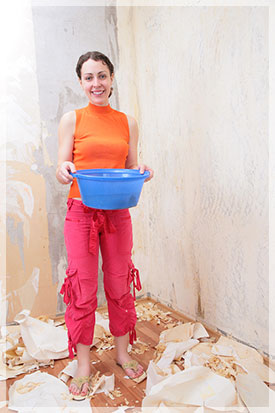The Right and Wrong Ways to Remove Wallpaper
Wallpaper removal is far more difficult than it appears. Often, a professional is needed, as the job becomes messy and time consuming very quickly. Not to mention, using the wrong tools may damage the wall’s surface.
No matter how you go about it, there are good practices – and some that should be avoided.
The Right Ways

- Keep the Floor and Trim Dry: Water and steam are often involved, so protect other surfaces – the floor, trim, furniture, vents, and artwork – by taping down plastic sheets.
- Turn Off All Electricity to the Room
- Pull Off the Material: Ideally, start at a corner and peel it off without water. In doing this, you’re taking off the top material while leaving the backing on the wall.
- Removing the Backing: At this point, water becomes necessary. Some professionals say to add it first, by sponge or a wet cloth, so that the paste absorbs it. From here, use a metal spatula or putty knife with rounded corners to remove as much paste as you can. Be aware: scraping too hard, especially on drywall, may damage the surface.
- Use a Gel Stripper: Paste may still remain after you scrape most of it off. As a result, some recommend adding a gel stripper to remove the rest. Can’t tell if it’s there? If the wall’s surface still has a shiny sheen to it, the backing isn’t completely gone.
- Use a Scoring Tool: As another option, score the surface first to allow the water to get through, and then remove the residue with a stripping solution.
- Try a Wallpaper Steamer: If you predict the material will be difficult to remove, which can be the case with 40-plus year old wallpaper, opt for a steamer to loosen it.
- Test the Paper: Even before you start the job, understand how long it will take and how difficult it could become by testing a corner. Remove the material here with a scraper; in the perfect scenario, it should come off in a long sheet.
- Use Protection: Do you plan to use chemicals? Equip yourself with goggles and gloves first.
The Wrong Ways
- Never Paint Over Wallpaper: Some call this a quick and affordable renovation job. However, the seams become extremely obvious very quickly, and when the wallpaper starts to peel, your entire paint job goes with it.
- The Tools are Too Strong: As mentioned above, opt for something rounded to prevent gouging the wall’s surface.
- Applying Too Much Pressure: Don’t force the wallpaper or backing to come off. If you press too hard, you’ll end up denting the wall.
In all cases, the right way to go about removing and installing wallpaper is with a professional’s assistance. If you’re located in New England, contact M. Brett Painting to learn more about our services.
